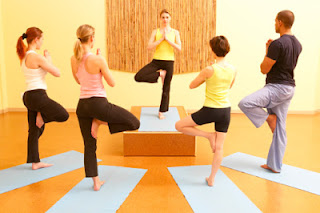Yoga teachers are certainly not expected to “know it all,” but students do anticipate a specific standard of knowledge and competence from an instructor. In order to be an effective teacher, you should possess a well-rounded body of knowledge, regarding Yoga’s history and roots, its benefits and cautions, and how to teach specific techniques. Most importantly, Yoga teachers should always have a source to consult when faced with unanswerable questions from students. As you gain experience teaching Yoga, and grow in your own practice, your knowledge base will also grow.
Lesson Plan – Sequence
When it comes to asanas, there are hundreds. Within those hundreds, there are many variations, depending on what type of Yoga you are teaching. If these numbers seem overwhelming, keep in mind that you do not have to know all of the asanas as a new Yoga teacher. However, instructors should know how to teach a core set of asanas. They should be able to put the poses together into a sequence, so students feel as if the class has a certain rhythm or theme.
When putting together a sequence, consider the starting point. Will the students be seated, lying on the floor, or standing? Ask yourself how you want the sequence to flow. Do you want it to start slow and easy, then move to more challenging poses, then end with more soothing, contemplative poses; or will the sequence revolve around a series of poses, such as a Sun Salutation? You can also group asanas by beginning with seated poses, moving to standing poses, and ending with floor poses.
Cueing
It is not enough for Yoga instructors to master the asanas. As a teacher, you should be able to demonstrate them to the students, while giving important verbal cues to look for within the body. For example, when teaching Warrior I pose (Virabhadrasana I), you must always remind the students to keep their front knee above the ankle, not the toes.
You must remind them to keep their hips faced forward, and their shoulders down (not locked into hyper-extension). Each pose has its own set of cues that help students perfect the asana to the best of their ability, as well as avoid injuries or strains. Keep in mind that demonstrating an asana is for the students to develop a mental picture of the posture. It is not about a perfect Yoga teacher modeling a perfect pose.
You must remind them to keep their hips faced forward, and their shoulders down (not locked into hyper-extension). Each pose has its own set of cues that help students perfect the asana to the best of their ability, as well as avoid injuries or strains. Keep in mind that demonstrating an asana is for the students to develop a mental picture of the posture. It is not about a perfect Yoga teacher modeling a perfect pose.
Observation
Always put yourself in a position to see exactly what all of your students are doing. This entails walking around the room – at times, when it would be impossible to know if your students are practicing correctly, unless you get off your mat to observe them. Turn your mat to face your students and always remember it is their class. Our personal practice does not take place during student class time.
Modification
As a Yoga teacher, you must realize everyone’s body is different. We cannot put students into a mold. Learn and develop the best methods for using props. Get past the idea that props are for beginners. Props are therapeutic and help students develop the best possible alignment for their bodies.
Adjustment – Assisting
Get permission before you make a physical assist. Take a specialized Yoga teacher training course if you do not know the rules of alignment for different bodies. For example: When teaching Triangle (Trikonasana), it might be impossible to adjust every student into perfect alignment. Be gentle, patient, compassionate, and never force muscles or joints. Do not spend all of your time “over handling” students. The best student experience is the culture we want to create during class time.
Risks
There are always certain risks involved with each pose. It is the Yoga teacher’s job to inform his or her students of all potential risks involved with each pose. A competent Yoga instructor should know the health and injury history of each student, in order to provide specific students with cautions or adaptations for poses.
© Copyright 2012 – Aura Wellness Center – Publications Division
To see our selection of inexpensive yoga teacher training courses, please visit the following link.
If you are a yoga teacher, studio owner, blogger, e-zine, or website publisher, and are in need of quality content, please feel free to use my blog entries (articles). Please be sure to reprint each article, as is, including the resource box above. Namaste!

This comment has been removed by a blog administrator.
ReplyDelete